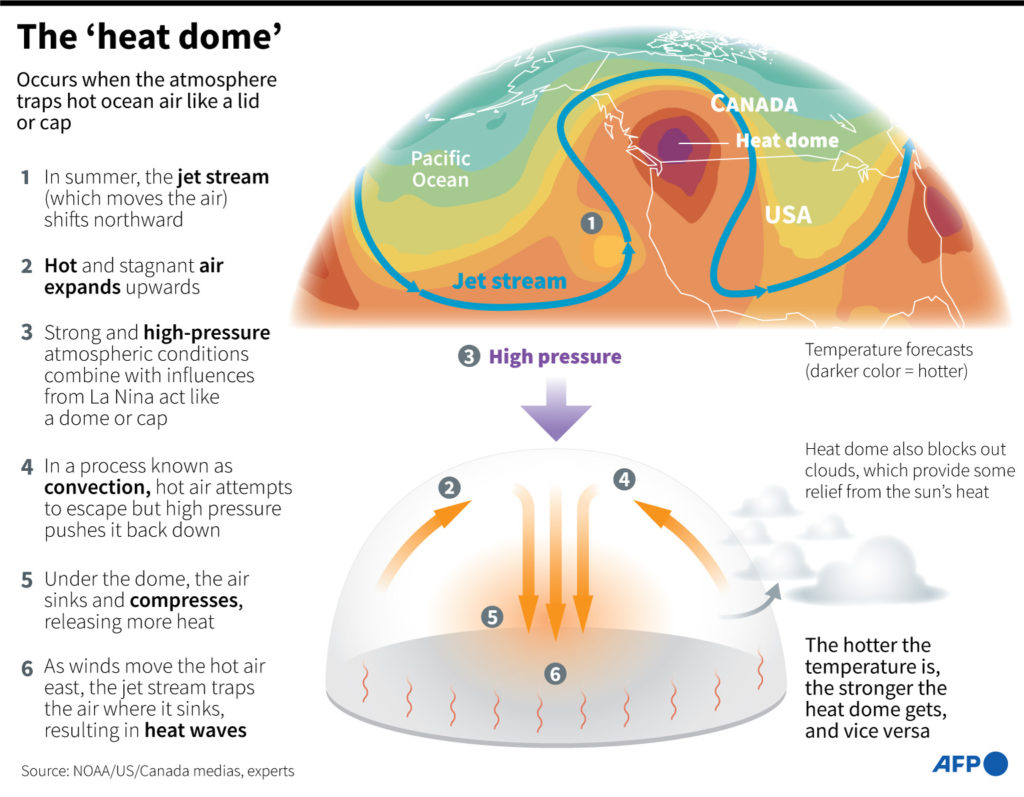ForumIAS announcing GS Foundation Program for UPSC CSE 2025-26 from 27th May. Click Here for more information.
Contents
Source: Indian Express, Hindustantimes, Livemint
Relevance: Important weather phenomenon impacting the climate and the people.
Synopsis: Parts of Canada and USA are reeling under severe heatwave caused due to a heat dome. Possible causes and likely impact are discussed.
Why in news?
High temperatures are being reported from the Pacific northwest (in USA) and some parts of Canada. This is a part of a “historic” heat wave that lasted over a week, a result of a phenomenon referred to as a “heat dome”.
- On June 29, temperatures in Portland (USA) advanced to 46.7oC. For three consecutive days, the city saw record temperatures. Before this, the highest temperatures were in August 1981 and July 1965.
- Canada too saw its highest temperature ever recorded in the country’s west. In Lytton in British Columbia, temperatures soared to over 46oC last week.
What is a heat dome?
According to The National Oceanic and Atmospheric Administration (NOAA), a heat dome occurs when the atmosphere traps hot ocean air like a lid or cap.
- Heat dome is more likely to form during La Niña years like 2021, when waters are cool in the eastern Pacific and warm in the western Pacific.
- The phenomenon begins when there is a strong change (or difference) in ocean temperatures. In the process known as convection, the temp difference causes more warm air, heated by the ocean surface, to rise over the ocean surface.
- That temperature difference creates winds that blow dense, tropical, western air eastward. Eventually that warm air gets trapped in the jet stream—a current of air spinning counterclockwise around the globe—and ends up on the U.S. West Coast, resulting in heatwaves.
- A heat wave is a period of unusually hot weather that lasts for more than two days. Heat waves can occur with or without high humidity and have the potential to cover a large area exposing a high number of people to hazardous heat.
- Impact of heat wave: So as long as the body is producing sweat, which is then able to evaporate quickly, the body will be able to remain cool even under high temperatures. But, there is a limit to this (a limit called the wet-bulb temperature) beyond which humans cannot tolerate high temperatures. Some heat-related illnesses include heat stroke, heat exhaustion, sunburn and heat rashes. Sometimes, heat-related illnesses can prove fatal.
- Wet Bulb temperature: is the lowest possible temperature that a surface can reach by evaporative cooling (i.e. that a wetted surface can reach with air passing over it) in a given spot.
- Example: To understand what causes a heat dome, one should liken the Pacific ocean to a large swimming pool in which the heater is turned on. Once the heater is on, the portions of the pool close to the heat source will warm up faster and therefore, the temperature in that area will be higher. In the same way, the western Pacific ocean’s temperatures have increased in the past few decades and are relatively more than the temperature in the eastern Pacific.

Impact of a heat dome
- Loss of life: Heat domes can lead to a sudden rise in fatalities due to extreme heat like those which are being reported in Canada and parts of the US. These fatalities happen especially amongst those living without an air conditioner.
- Damage to crops: The trapping of heat can also damage crops, dry out vegetation and result in droughts.
- Rise in energy consumption: The heat wave will also lead to rise in energy demand, especially electricity, leading to pushing up rates.
- Increase in wildfires: The heat domes can also act as fuel to wildfires, which destroys a lot of land area in the US every year.
- Heat dome also prevents clouds from forming, allowing for more radiation from the sun to hit the ground.
Are heat domes linked to climate change?
It’s challenging to link any one specific weather event with climate change, but over time the trend is showing longer-lasting, more intense heat.
- Climate change certainly influences hot weather: It is making heat more extreme and such extreme heat will occur more frequently.
- In Russia, cities as far north as the Arctic circle broke heat records this month.
| Also Read: What are marine heatwaves? |




